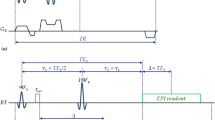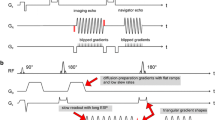Abstract
Objective
The purpose of this work was to optimize the acquisition of diffusion-weighted (DW) single-refocused spin-echo (srSE) data without intrinsic eddy-current compensation (ECC) for an improved performance of ECC postprocessing. The rationale is that srSE sequences without ECC may yield shorter echo times (TE) and thus higher signal-to-noise ratios (SNR) than srSE or twice-refocused spin-echo (trSE) schemes with intrinsic ECC.
Materials and methods
The proposed method employs dummy scans with DW gradients to drive eddy currents into a steady state before data acquisition. Parameters of the ECC postprocessing algorithm were also optimized. Simulations were performed to obtain minimum TE values for the proposed sequence and sequences with intrinsic ECC. Experimentally, the proposed method was compared with standard DW-trSE imaging, both in vitro and in vivo.
Results
Simulations showed substantially shorter TE for the proposed method than for methods with intrinsic ECC when using shortened echo readouts. Data of the proposed method showed a marked increase in SNR. A dummy scan duration of at least 1.5 s improved performance of the ECC postprocessing algorithm.
Conclusion
Changes proposed for the DW-srSE sequence and for the parameter setting of the postprocessing ECC algorithm considerably reduced eddy-current artifacts and provided a higher SNR.









Similar content being viewed by others
References
Le Bihan D, Mangin JF, Poupon C, Clark CA, Pappata S, Molko N, Chabriat H (2001) Diffusion tensor imaging: concepts and applications. J Magn Reson Imaging 13(4):534–546
Mori S, Zhang J (2006) Principles of diffusion tensor imaging and its applications to basic neuroscience research. Neuron 51(5):527–539
Lerner A, Mogensen MA, Kim PE, Shiroishi MS, Hwang DH, Law M (2014) Clinical applications of diffusion tensor imaging. World Neurosurg 82(1):96–109
Stejskal EO, Tanner JE (1965) Spin diffusion measurements: spin echoes in the presence of a time-dependent field gradient. J Chem Phys 42(1):288–292
Turner R, Le Bihan D, Maier J, Vavrek R, Hedges LK, Pekar J (1990) Echo-planar imaging of intravoxel incoherent motion. Radiology 177(2):407–414
Jezzard P, Barnett AS, Pierpaoli C (1998) Characterization of and correction for eddy current artifacts in echo planar diffusion imaging. Magn Reson Med 39(5):801–812
Le Bihan D, Poupon C, Amadon A, Lethimonnier F (2006) Artifacts and pitfalls in diffusion MRI. J Magn Reson Imaging 24(3):478–488
Alexander AL, Tsuruda JS, Parker DL (1997) Elimination of eddy current artifacts in diffusion-weighted echo-planar images: the use of bipolar gradients. Magn Reson Med 38(6):1016–1021
Finsterbusch J (2009) Eddy-current compensated diffusion weighting with a single refocusing RF pulse. Magn Reson Med 61(3):748–754
Aliotta E, Moulin K, Ennis DB (2018) Eddy current–nulled convex optimized diffusion encoding (EN-CODE) for distortion-free diffusion tensor imaging with short echo times. Magn Reson Med 79(2):663–672
Calamante F, Porter DA, Gadian DG, Connelly A (1999) Correction for eddy current induced Bo shifts in diffusion-weighted echo-planar imaging. Magn Reson Med 41(1):95–102
Boesch C, Gruetter R, Martin E (1991) Temporal and spatial analysis of fields generated by eddy currents in superconducting magnets: optimization of corrections and quantitative characterization of magnet/gradient systems. Magn Reson Med 20(2):268–284
Heid O (2000). Eddy current-nulled diffusion weighting. In: Proceedings of the 8th annual meeting of ISMRM, Denver, p 799
Reese TG, Heid O, Weisskoff RM, Wedeen VJ (2003) Reduction of eddy-current-induced distortion in diffusion MRI using a twice-refocused spin echo. Magn Reson Med 49(1):177–182
Chan RW, von Deuster C, Giese D, Stoeck CT, Harmer J, Aitken AP, Atkinson D, Kozerke S (2014) Characterization and correction of eddy-current artifacts in unipolar and bipolar diffusion sequences using magnetic field monitoring. J Magn Reson 244:74–84
Vannesjo SJ, Haeberlin M, Kasper L, Pavan M, Wilm BJ, Barmet C, Pruessmann KP (2013) Gradient system characterization by impulse response measurements with a dynamic field camera. Magn Reson Med 69(2):583–593
Jenkinson M, Beckmann CF, Behrens TEJ, Woolrich MW, Smith SM (2012) FSL. NeuroImage 62:782–790
Smith SM, Jenkinson M, Woolrich MW, Beckmann CF, Behrens TE, Johansen-Berg H, Bannister PR, De Luca M, Drobnjak I, Flitney DE, Niazy RK, Saunders J, Vickers J, Zhang Y, De Stefano N, Brady JM, Matthews PM (2004) Advances in functional and structural MR image analysis and implementation as FSL. NeuroImage 23:S208–S219
Andersson JLR, Sotiropoulos SN (2016) An integrated approach to correction for off-resonance effects and subject movement in diffusion MR imaging. NeuroImage 125:1063–1078
Griswold MA, Jakob PM, Heidemann RM, Nittka M, Jellus V, Wang J, Kiefer B, Haase A (2002) Generalized autocalibrating partially parallel acquisitions (GRAPPA). Magn Reson Med 47(6):1202–1210
Jones DK, Horsfield MA, Simmons A (1999) Optimal strategies for measuring diffusion in anisotropic systems by magnetic resonance imaging. Magn Reson Med 42(3):515–525
Andersson JLR, Skare S, Ashburner J (2003) How to correct susceptibility distortions in spin-echo echo-planar images: application to diffusion tensor imaging. NeuroImage 20:870–888
Mugler JP, Brookeman JR (1990) Three-dimensional magnetization-prepared rapid gradient-echo imaging (3D MP RAGE). Magn Reson Med 15(1):152–157
Deichmann R, Good CD, Josephs O, Ashburner J, Turner R (2000) Optimization of 3-D MP-RAGE sequences for structural brain imaging. NeuroImage 12(1):112–127
Smith SM (2002) Fast robust automated brain extraction. Hum Brain Mapp 17:143–155
Deichmann R (2006) Fast structural brain imaging using an MDEFT sequence with a FLASH–EPI hybrid readout. NeuroImage 33(4):1066–1071
Constantinides CD, Atalar E, McVeigh ER (1997) Signal-to-noise measurements in magnitude images from NMR phased arrays. Magn Reson Med 38(5):852–857
Nöth U, Shrestha M, Schüre JR, Deichmann R (2017) Quantitative in vivo T2 mapping using fast spin echo techniques-a linear correction procedure. NeuroImage 157:476–485
Feinberg DA, Moeller S, Smith SM, Auerbach E, Ramanna S, Gunther M, Glasser MF, Miller KL, Ugurbil K, Yacoub E (2010) Multiplexed echo planar imaging for sub-second whole brain FMRI and fast diffusion imaging. PLoS One 5(12):e15710
Spees WM, Buhl N, Sun P, Ackerman JJ, Neil JJ, Garbow JR (2011) Quantification and compensation of eddy-current-induced magnetic-field gradients. J Magn Reson 212(1):116–123
Mohammadi S, Möller HE, Kugel H, Müller DK, Deppe M (2010) Correcting eddy current and motion effects by affine whole-brain registrations: evaluation of three-dimensional distortions and comparison with slicewise correction. Magn Reson Med 64(4):1047–1056
Horsfield MA (1999) Mapping eddy current induced fields for the correction of diffusion-weighted echo planar images. Magn Reson Imaging 17(9):1335–1345
Author information
Authors and Affiliations
Contributions
MS, PH, RD protocol/project development. BL, UN, MS Data collection or management. PH, MS data analysis.
Corresponding author
Ethics declarations
Conflict of interest
The authors declare they have no conflict of interest.
Ethical approval
All procedures performed in the vivo study were approved by the local ethics committee of the University Hospital.
Informed consent
Written informed consent was obtained from all healthy participants before scanning.
Rights and permissions
About this article
Cite this article
Shrestha, M., Hok, P., Nöth, U. et al. Optimization of diffusion-weighted single-refocused spin-echo EPI by reducing eddy-current artifacts and shortening the echo time. Magn Reson Mater Phy 31, 585–597 (2018). https://doi.org/10.1007/s10334-018-0684-x
Received:
Revised:
Accepted:
Published:
Issue Date:
DOI: https://doi.org/10.1007/s10334-018-0684-x




